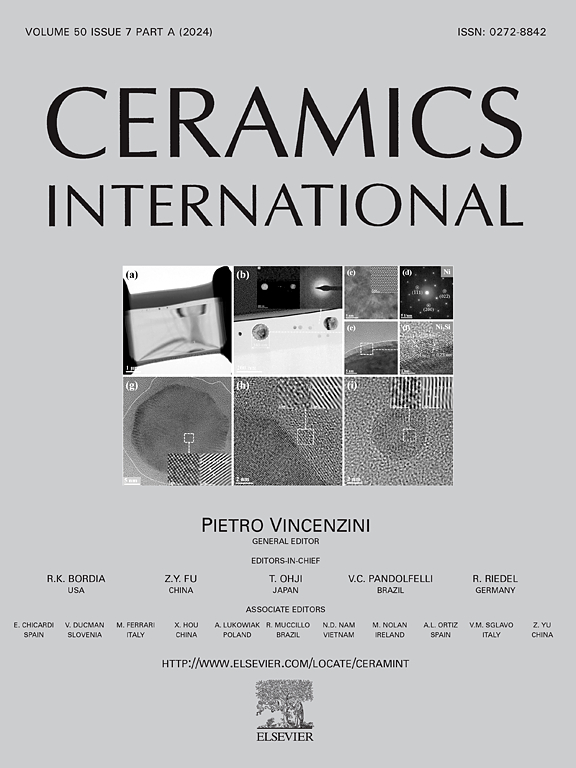Isothermal temperature oxidation behavior and mechanism of REB2C2 ceramics (RE = Y, Gd, Dy, Ho, Er) at 800–1000 °C in air
IF 5.1
2区 材料科学
Q1 MATERIALS SCIENCE, CERAMICS
引用次数: 0
Abstract
In this study, the isothermal oxidation behavior of several high-purity REB2C2 (RE = Y, Gd, Dy, Ho, Er) ceramics in air at 800–1000 °C for 20 h was investigated for the first time. The results indicated that the oxidation of most REB2C2 (RE = Y, Dy, Ho, Er) follows a parabolic law and demonstrates good oxidation resistance. The superior oxidation resistance of these REB2C2 (RE = Y, Dy, Ho, Er) ceramics can be attributed to the formation of a continuous, dense oxide layer composed of REBO3 (RE = Y, Dy, Ho, Er) and amorphous B2O3 on the substrate surface during the oxidation process. This dense oxide layer effectively reduces oxygen transport and decreases the oxidation rate through a diffusion-controlled mechanism, thereby isolating the substrate from oxygen exposure and protecting the underlying material. However, as the oxidation temperature increased, the oxide layer was primarily composed of REBO3 particles, and there were more pores resulting from the volatilization of amorphous B2O3. At an oxidation temperature of 1000 °C, the particle size of REBO3 increased, which facilitated the reduction of pores and helped maintain the density of the oxide layer. Notably, ErBO3 exhibited a significant increase in particle size, leading to the densest oxide layer and demonstrating the best oxidation resistance. In contrast, GdB2C2 showed a linear increase in mass gain and exhibited relatively poor oxidation resistance.
REB2C2陶瓷(RE = Y, Gd, Dy, Ho, Er)在800-1000℃空气中的等温氧化行为及机理
本文首次研究了几种高纯REB2C2 (RE = Y, Gd, Dy, Ho, Er)陶瓷在800-1000℃空气中等温氧化20 h的行为。结果表明,大多数REB2C2 (RE = Y, Dy, Ho, Er)的氧化服从抛物线规律,具有良好的抗氧化性。这些REB2C2 (RE = Y, Dy, Ho, Er)陶瓷优异的抗氧化性可归因于在氧化过程中在衬底表面形成由REBO3 (RE = Y, Dy, Ho, Er)和无定形B2O3组成的连续致密的氧化层。这种致密的氧化层通过扩散控制机制有效地减少了氧气的传输,降低了氧化速率,从而使衬底与氧气隔绝,保护了底层材料。然而,随着氧化温度的升高,氧化层主要由REBO3颗粒组成,无定形B2O3的挥发导致孔隙增多。在1000℃的氧化温度下,REBO3的粒径增大,有利于孔隙的减少,有利于保持氧化层的密度。值得注意的是,ErBO3的粒径显著增加,形成了最致密的氧化层,并表现出最佳的抗氧化性。相比之下,GdB2C2的质量增加呈线性增长,抗氧化性能相对较差。
本文章由计算机程序翻译,如有差异,请以英文原文为准。
求助全文
约1分钟内获得全文
求助全文
来源期刊

Ceramics International
工程技术-材料科学:硅酸盐
CiteScore
9.40
自引率
15.40%
发文量
4558
审稿时长
25 days
期刊介绍:
Ceramics International covers the science of advanced ceramic materials. The journal encourages contributions that demonstrate how an understanding of the basic chemical and physical phenomena may direct materials design and stimulate ideas for new or improved processing techniques, in order to obtain materials with desired structural features and properties.
Ceramics International covers oxide and non-oxide ceramics, functional glasses, glass ceramics, amorphous inorganic non-metallic materials (and their combinations with metal and organic materials), in the form of particulates, dense or porous bodies, thin/thick films and laminated, graded and composite structures. Process related topics such as ceramic-ceramic joints or joining ceramics with dissimilar materials, as well as surface finishing and conditioning are also covered. Besides traditional processing techniques, manufacturing routes of interest include innovative procedures benefiting from externally applied stresses, electromagnetic fields and energetic beams, as well as top-down and self-assembly nanotechnology approaches. In addition, the journal welcomes submissions on bio-inspired and bio-enabled materials designs, experimentally validated multi scale modelling and simulation for materials design, and the use of the most advanced chemical and physical characterization techniques of structure, properties and behaviour.
Technologically relevant low-dimensional systems are a particular focus of Ceramics International. These include 0, 1 and 2-D nanomaterials (also covering CNTs, graphene and related materials, and diamond-like carbons), their nanocomposites, as well as nano-hybrids and hierarchical multifunctional nanostructures that might integrate molecular, biological and electronic components.
 求助内容:
求助内容: 应助结果提醒方式:
应助结果提醒方式:


